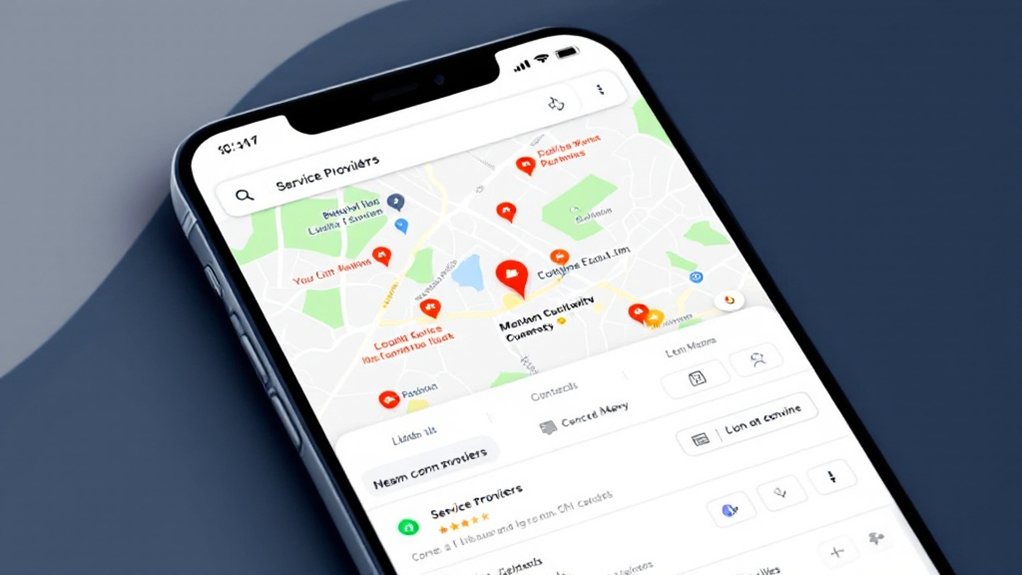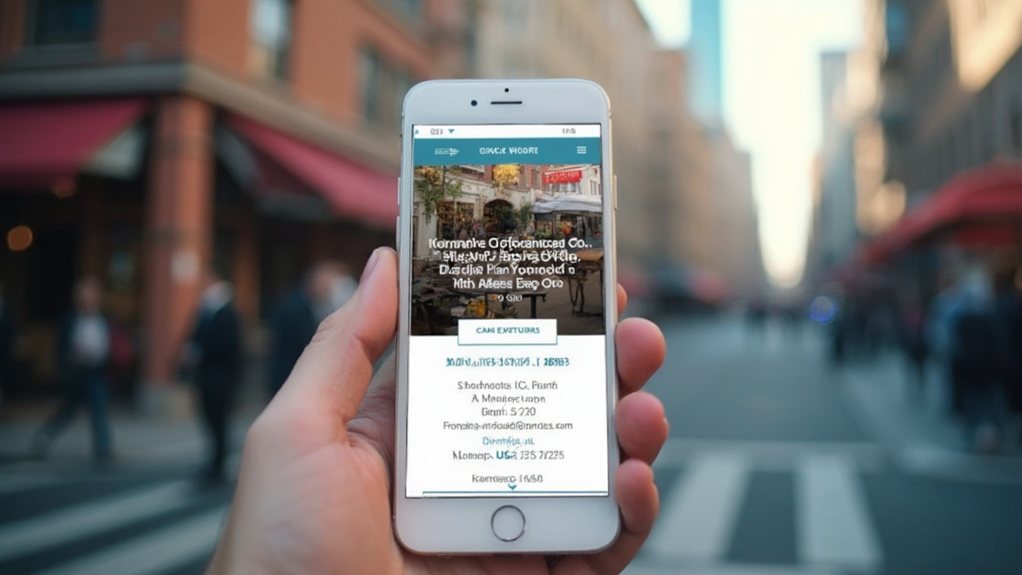To optimize your mobile service pages for local users, start by ensuring your website is responsive and adapts to any device. Compress media, use a content delivery network, and prioritize key mobile-friendly content. Incorporate explicit local keywords and leverage long-tail queries to reach nearby customers. Boost page speed and load times to keep users engaged. Claim and optimize your Google My Business profile, and encourage positive reviews to build trust. There's more you can do to further improve your local mobile presence.
Responsive Design for Mobile Optimization

The prevalence of mobile traffic, with over 52% of web access occurring on smartphones and tablets, has made responsive design a critical component of modern website optimization. About 90% of websites now employ responsive techniques, allowing content to adapt seamlessly to any device. This mobile-friendly approach is crucial, as 72% of users favor websites optimized for their devices. Smartphone e-commerce is predicted to account for 72.9% of online retail sales in 2021. Poor mobile experiences can even deter potential customers, with 57% less likely to recommend a business. Responsive design boosts conversion rates, improves search rankings, and provides a competitive advantage. By leveraging flexible grids, adaptive images, and streamlined content, you can create an engaging, high-performing mobile presence for your local service business.
Enhancing Mobile User Experience

Though mobile optimization is crucial, enhancing the overall mobile user experience is equally paramount. By compressing media, optimizing file sizes, and leveraging content delivery networks, you can significantly boost page speed. Additionally, creating intuitive menus, clear pathways, and touch-friendly elements can vastly improve mobile navigation. Prioritizing key content is crucial for optimizing your mobile content for users. Lastly, using concise headings and implementing a scannable layout will further enhance the mobile user experience.
- Reduce initial load times by lazy loading images and videos.
- Simplify forms and decision-making processes to minimize user friction.
- Employ high-contrast colors and mobile-friendly fonts for exceptional aesthetics.
Local Keyword Targeting for Mobile Content

Enhancing the mobile user experience is just the first step. To truly optimize your mobile service pages for local users, you must leverage local keyword targeting. Incorporate explicit keywords, like "dentist in Boston", and implicit keywords that convey local intent without directly mentioning a location. Use location-based terms, like city names, and keyword modifiers to refine your search queries. Targeting nearby areas the business serves can increase visibility to potential customers in adjacent areas. Don't forget about long-tail keywords – they may have lower competition but can be highly relevant. Conduct thorough keyword research, analyze your competitors, and track mobile-specific search trends. Then, seamlessly integrate local keywords into your page content, meta tags, and internal linking structure. By targeting mobile users with hyper-local optimization, you can boost your visibility and attract the right customers.
Improving Mobile Page Speed and Load Times
Ensuring fast mobile page load times is crucial for engaging local users. Mobile site speed affects search engine ranking, conversion rates, and bounce rates. Minimize server latency and optimize website assets like images, CSS, and JavaScript to deliver lightning-fast experiences. Implement caching strategies and server-side optimizations to keep your mobile pages running smoothly. Businesses and marketers must design and develop fast mobile site experiences to stay competitive.
Minimize Server Latency
Optimizing your mobile service pages for local users begins with minimizing server latency. By leveraging robust servers, modern connection protocols, and high-end databases, you can streamline your infrastructure for improved performance.
- Upgrade to servers with powerful CPUs, ample RAM, and fast storage like SSDs to reduce latency.
- Leverage HTTP/2 and QUIC protocols for enhanced speed and efficiency.
- Optimize your database with efficient querying capabilities to expedite data retrieval.
- Leveraging CDNs can further reduce latency by caching content closer to the end-user.
Complement these efforts with effective load balancing and a distributed server architecture to handle high traffic volumes. Taking these steps will ensure your mobile pages load swiftly for local users, delivering a seamless experience.
Optimize Website Assets
To ensure your mobile site performs optimally, you'll need to supercharge your website assets. Start by optimizing image formats – use WebP for superior compression and quality. Compress and resize images to mobile-friendly sizes without sacrificing quality. Leverage content delivery networks to improve distribution and reduce load times. Implement lazy loading to delay non-critical image loading until users scroll. Minify HTML, CSS, and JavaScript to trim file sizes. Load assets asynchronously to prevent render-blocking. Eliminate unused code and leverage the latest web technologies. Utilize browser caching to store frequently accessed resources locally. Maintain a mobile-first design with simple elements and vector graphics. Lastly, ensure your responsive WordPress theme is optimized for mobile performance. [Implement AMP to further improve mobile page speed and user experience.
Optimizing Mobile-Friendly Content Structure
When optimizing content for mobile devices, you'll want to break down long blocks of text into smaller, more manageable sections. This "chunking" approach improves readability on the go. Chunking makes content more "snackable" for mobile readers. Additionally, ensure your website uses responsive design to adapt seamlessly to different screen sizes. Finally, incorporate relevant images that enhance the content without compromising legibility on small screens.
- Use clear headings and subheadings to guide readers through your content.
- Keep paragraphs short, with 3-4 sentences or less.
- Leverage bold formatting and bullet points to highlight critical information.
Leveraging Google My Business for Local Visibility
Claim your Google My Business profile and optimize it with accurate business details, relevant categories, and a compelling description. Ensure name, address, and phone number consistency across online platforms to boost your local SEO. Leverage features like Google Posts to showcase your offerings and engage with customers. Monitor your profile insights to adjust your local marketing strategies and encourage positive reviews.
Claim and Optimize Profiles
Why is claiming and verifying your business profile on Google My Business crucial for local visibility? Claiming your profile prevents unauthorized changes and ensures you control your business data. Verification through postcard, phone, or email boosts your credibility, making your business more reputable to potential customers. Additionally:
- Providing accurate business information during verification is essential to avoid any issues. Regular profile updates are necessary to reflect any changes to your business details.
- Completing your profile with comprehensive details, high-quality photos, and videos can significantly improve your local search rankings.
- Selecting the right primary and secondary categories helps Google understand your offerings, ensuring your business appears in relevant local searches.
Showcase Business Information
Optimizing your Google My Business profile is key to showcasing your business information and improving local visibility. Ensure your name, address, and phone number (NAP) are accurate and consistent across all platforms. Maintain identical NAP across all online citations to reinforce your local presence. Update your business hours, including any special hours, to keep customers informed. Select the most relevant primary and secondary categories to increase search relevance. Use high-quality photos to showcase your location, products, or services. Provide detailed product and service descriptions to attract targeted searches. Maintaining NAP consistency, encouraging positive reviews, and integrating with Google Maps will further boost your local SEO. Consistently updating your profile and analyzing performance insights will help you make data-driven decisions to optimize your local presence.
Leverage Google Posts
How can you leverage Google Posts to boost your local visibility? Google Posts allow you to share real-time updates, offers, and events directly on your Google Business Profile. Here are three ways to maximize their impact:
- Craft visually-engaging posts with clear calls-to-action to drive conversions.
- Incorporate relevant local keywords to enhance discoverability in search.
- Maintain consistency by posting regularly to keep your profile fresh and appealing to potential customers.
Consistent NAP Information Across Platforms
Maintaining consistent NAP (Name, Address, and Phone number) information across various online platforms is crucial for your local SEO efforts. Inconsistent NAP data can confuse customers and negatively impact your search rankings. Accurate and consistent NAP helps verify your business's legitimacy, enhancing trust with search engines and improving your local visibility. Ensure you claim and update your listings on platforms like Google My Business, and standardize your NAP formatting to avoid variations. Regularly audit your online presence and make necessary updates to maintain a coherent brand identity. Leveraging tools and professional services can simplify the process of managing your NAP citations effectively.
Incorporating Schema Markup for Mobile Search
One of the most effective ways to enhance the visibility and relevance of your mobile service pages is to incorporate schema markup. This structured data format clarifies your business details, services, and other crucial information for search engines, leading to improved local SEO, enhanced rich snippets, and a competitive edge in SERPs.
To implement schema effectively, consider these steps:
- Select relevant schemas that accurately represent your services and business details.
- Utilize the preferred JSON-LD format for easy crawling and organization by search engines.
- Leverage tools like Google's Structured Data Markup Helper to simplify the implementation process.
Encouraging Local Citations and Reviews
Claim your local business listings to ensure consistent name, address, and phone number (NAP) across directories. Encourage customers to leave reviews on platforms like Google My Business and TripAdvisor to boost your online reputation. Regularly monitor and respond to reviews, both positive and negative, to maintain a professional online presence.
Claim Local Listings
When you claim your local listings, you'll be able to maintain consistent business information across the internet, which can significantly improve your local SEO. Claiming your listings enhances brand visibility in local search results and builds trust among potential customers. Additionally, it supports your local marketing efforts by reaching targeted audiences.
To claim your local listings, follow these steps:
- Sign in to Google My Business and verify your business ownership.
- Complete and update all business details accurately.
- Monitor and correct any listing discrepancies to ensure consistent information.
Optimizing your mobile service pages with claimed local listings can boost your online presence, credibility, and search engine trust, ultimately driving more customers to your business.
Encourage Review Creation
As you look to optimize your mobile service pages, encouraging review creation is a crucial step. Google My Business is vital for managing your local reputation, while Yelp and industry-specific platforms like TripAdvisor can drive valuable reviews. Time your requests strategically – immediately after a customer's experience or after successful support interactions. Leverage email, in-person interactions, and text messages to personalize your review requests. Offer small, ethical incentives and showcase customer reviews for social proof. Diversify your review presence across multiple platforms to ensure maximum visibility. Remember, a strong review profile can significantly impact your local search rankings and credibility with potential customers.
Monitor Review Responses
Closely monitoring your review responses goes hand-in-hand with building a robust local presence. Utilizing tools like Google Alerts helps you track mentions of your business, enabling swift responses to reviews. This not only addresses customer concerns but also demonstrates your commitment to providing excellent service.
Consider these strategies:
- Respond promptly to both positive and negative reviews, showcasing your responsiveness and dedication to customer satisfaction.
- Personalize your responses to acknowledge individual feedback and foster a genuine connection with your audience.
- Analyze review data to identify areas for improvement, ensuring your mobile service pages continuously meet the evolving needs of local users.
Ensuring Accessibility and Voice Search Compatibility
Why is ensuring accessibility and voice search compatibility crucial for optimizing mobile service pages for local users? Over 96% of top websites have accessibility issues, and most users access the web via mobile. With 16% of the world's population experiencing significant disabilities, catering to their needs is essential. Providing alternative text for images, ensuring low contrast text, and incorporating ARIA usage can significantly improve accessibility. Additionally, optimizing for voice search is vital, as it's increasingly popular. Designing intuitive voice interactions and ensuring WCAG compliance for interactions will enhance user experience. By addressing these accessibility and voice search considerations, you can create mobile service pages that effectively engage local users.
